- Lesson One: The Number One
- ... in Geometry
- ... in Nature
- ... in Culture
- "Uroboros" (related artwork by the author)
- "Creation" (related artwork by the author)
- Lesson Two: The Square Root of Two
- ... in Geometry
- ... in Nature, Part 1
- ... in Nature, Part 2
- ... in Culture, Part 1
- ... in Culture, Part 2
- "Duality" (related artwork by the author)
- Lesson Three: The Square Root of Three
- ... in Geometry
- ... in Nature
- ... in Culture
- "Vesica" (related artwork by the author)
- Lesson Four: Phi, or the Golden Proportion
- ... Intro, Part 2
- ... Intro, Part 3
- ... in Geometry
- ... in Nature
- ... in Nature, Part 2
- ... in Culture
- "The Flower of Phi" (related artwork by the author)
- Lesson Five: The Five Perfect Solids
- ... Intro, Part 2
- ... The Tetrahedron
- ... The Octahedron
- ... The Cube
- ... The Icosahedron
- ... The Dodecahedron
Phi in Insect and Animal Forms:
As with plants, the proportion of 1:1.618 can be found in the structure of many insect and animal bodies.
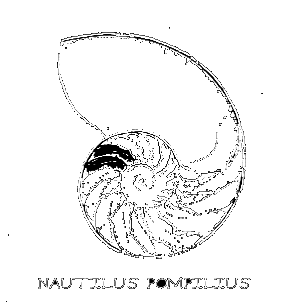 Taken From: Robert Lawlor's book Sacred Geometry; Philosophy and Practice, Thames and Hudson, 1982
Taken From: Robert Lawlor's book Sacred Geometry; Philosophy and Practice, Thames and Hudson, 1982Probably the most famous of all uses of Phi related proportions is that of the Nautilus shell, which adheres quite directly to the Golden Spiral. As mentioned prior, the Golden Spiral is the most perfect spiral when considering self replication through continual growth, and it is for this very reason that many shelled creatures employ it in their forms. By growing in this manner the shell can grow to any size and retain excellent balance and structural integrity.
Many other sea animals besides the Nautilus utilize the Phi proportion in their bodily forms as well. If we consider for a moment the pentagon - Phi relation, many examples immediately leap to mind. Amongst them we find (images above left to right) the Sea Cucumber (which reveals its pentagonal symmetry when sliced horizontally), Radiolarian, Starfish, and Stingray.
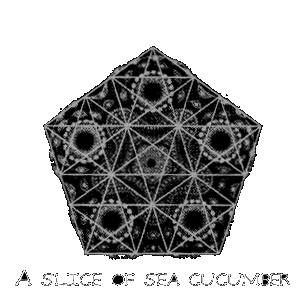 Taken From: Michael Schneider's book A Beginner's Guide to Constructing the Universe, HarperPerennial, 1995
Taken From: Michael Schneider's book A Beginner's Guide to Constructing the Universe, HarperPerennial, 1995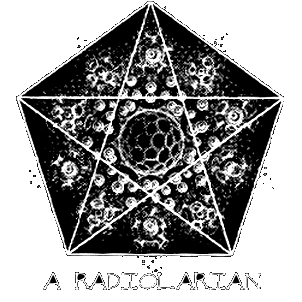 Taken From: Michael Schneider's book A Beginner's Guide to Constructing the Universe, HarperPerennial, 1995
Taken From: Michael Schneider's book A Beginner's Guide to Constructing the Universe, HarperPerennial, 1995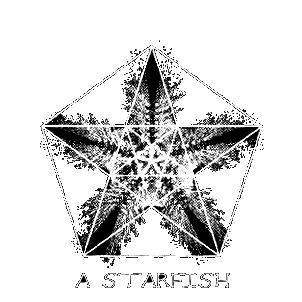 Taken From: Michael Schneider's book A Beginner's Guide to Constructing the Universe, HarperPerennial, 1995
Taken From: Michael Schneider's book A Beginner's Guide to Constructing the Universe, HarperPerennial, 1995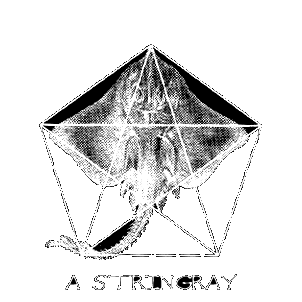
Continuing with our look at pentagonal symmetry, take a look at the proportions of a domestic cat's face:
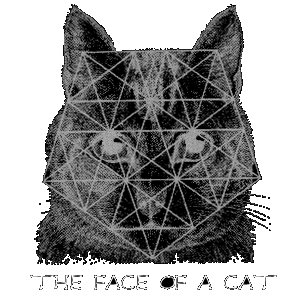 Taken From: Michael Schneider's book A Beginner's Guide to Constructing the Universe, HarperPerennial, 1995
Taken From: Michael Schneider's book A Beginner's Guide to Constructing the Universe, HarperPerennial, 1995 Taken From: Robert Lawlor's book Sacred Geometry; Philosophy and Practice, Thames and Hudson, 1982
Taken From: Robert Lawlor's book Sacred Geometry; Philosophy and Practice, Thames and Hudson, 1982Perhaps most relevant to all of us is the fact that the Phi proportion can be found throughout the human body. The idea of the pentagonal symmetry of the human body may have been most popularized by Leonardo DeVinci's artwork (presented in the earlier section "One in Nature"), and here is represented quite cleary in a similar image
But the human body / phi connection do not stop at the simple relation of the human body to the five pointed star. The Phi proportion itself can be found in the very bones that form our body's skeleton. For example, the three bones of any finger are related to one another by 1.618...:
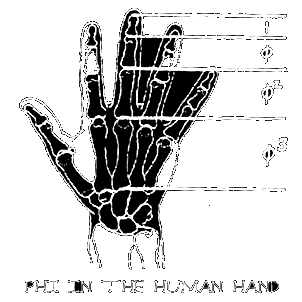 Taken From: Michael Schneider's book A Beginner's Guide to Constructing the Universe, HarperPerennial, 1995
Taken From: Michael Schneider's book A Beginner's Guide to Constructing the Universe, HarperPerennial, 1995Also, the wrist joint cuts the length from fingertip to elbow at 0.618.
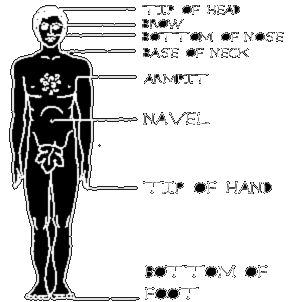 Taken From: Michael Schneider's book A Beginner's Guide to Constructing the Universe, HarperPerennial, 1995
Taken From: Michael Schneider's book A Beginner's Guide to Constructing the Universe, HarperPerennial, 1995The navel divides the length of the body from head to tow at the Golden Section, the brow divides the face from the peak of the skull to the bottom of the chin, and the bottom of the nose marks the same division between the chin and brow.
These are not all of the Phi proportions that can be found in the human body, but they are certainly enough to show that Phi is not only a number that can be found in the natural world all around us, but is also something that is within us - an intrinsic part of our very physicality.


